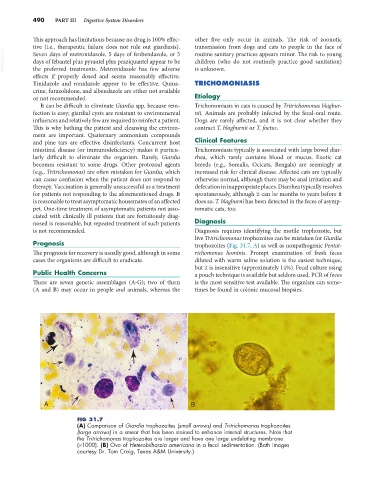Page 518 - Small Animal Internal Medicine, 6th Edition
P. 518
490 PART III Digestive System Disorders
This approach has limitations because no drug is 100% effec- other five only occur in animals. The risk of zoonotic
tive (i.e., therapeutic failure does not rule out giardiasis). transmission from dogs and cats to people in the face of
VetBooks.ir Seven days of metronidazole, 5 days of fenbendazole, or 5 routine sanitary practices appears minor. The risk to young
children (who do not routinely practice good sanitation)
days of febantel plus pyrantel plus praziquantel appear to be
the preferred treatments. Metronidazole has few adverse
effects if properly dosed and seems reasonably effective. is unknown.
Tinidazole and ronidazole appear to be effective. Quina- TRICHOMONIASIS
crine, furazolidone, and albendazole are either not available
or not recommended. Etiology
It can be difficult to eliminate Giardia spp. because rein- Trichomoniasis in cats is caused by Tritrichomonas blagbur-
fection is easy; giardial cysts are resistant to environmental nii. Animals are probably infected by the fecal-oral route.
influences and relatively few are required to reinfect a patient. Dogs are rarely affected, and it is not clear whether they
This is why bathing the patient and cleansing the environ- contract T. blagburnii or T. foetus.
ment are important. Quaternary ammonium compounds
and pine tars are effective disinfectants. Concurrent host Clinical Features
intestinal disease (or immunodeficiency) makes it particu- Trichomoniasis typically is associated with large bowel diar-
larly difficult to eliminate the organism. Rarely, Giardia rhea, which rarely contains blood or mucus. Exotic cat
becomes resistant to some drugs. Other protozoal agents breeds (e.g., Somalis, Ocicats, Bengals) are seemingly at
(e.g., Tritrichomonas) are often mistaken for Giardia, which increased risk for clinical disease. Affected cats are typically
can cause confusion when the patient does not respond to otherwise normal, although there may be anal irritation and
therapy. Vaccination is generally unsuccessful as a treatment defecation in inappropriate places. Diarrhea typically resolves
for patients not responding to the aforementioned drugs. It spontaneously, although it can be months to years before it
is reasonable to treat asymptomatic housemates of an affected does so. T. blagburni has been detected in the feces of asymp-
pet. One-time treatment of asymptomatic patients not asso- tomatic cats, too.
ciated with clinically ill patients that are fortuitously diag-
nosed is reasonable, but repeated treatment of such patients Diagnosis
is not recommended. Diagnosis requires identifying the motile trophozoite, but
live Tritrichomonas trophozoites can be mistaken for Giardia
Prognosis trophozoites (Fig. 31.7, A) as well as nonpathogenic Pentat-
The prognosis for recovery is usually good, although in some richomonas hominis. Prompt examination of fresh feces
cases the organisms are difficult to eradicate. diluted with warm saline solution is the easiest technique,
but it is insensitive (approximately 14%). Fecal culture using
Public Health Concerns a pouch technique is available but seldom used. PCR of feces
There are seven genetic assemblages (A-G); two of them is the most sensitive test available. The organism can some-
(A and B) may occur in people and animals, whereas the times be found in colonic mucosal biopsies.
A B
FIG 31.7
(A) Comparison of Giardia trophozoites (small arrows) and Tritrichomonas trophozoites
(large arrows) in a smear that has been stained to enhance internal structures. Note that
the Tritrichomonas trophozoites are larger and have one large undulating membrane
(×1000). (B) Ova of Heterobilharzia americana in a fecal sedimentation. (Both images
courtesy Dr. Tom Craig, Texas A&M University.)

